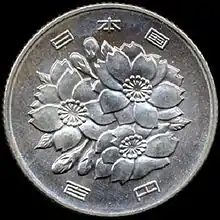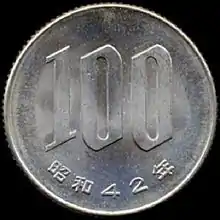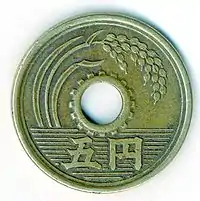100 yen coin
The 100 yen coin (百円硬貨, Hyaku-en kōka) is a denomination of Japanese yen. The current design was first minted in silver in 1959 and saw a change of metal in 1967.[1] It is the second-highest denomination coin in Japan after the 500 yen coin. The current 100 yen coin is one of two denominations which depict the emperor's rule date in Arabic numerals rather than Kanji. These numbers go from "昭和42" Shōwa, 42nd year of reign (1967) to "令和2" Reiwa, 2nd year of reign (2020).
Japan | |
| Value | 100 Japanese yen |
|---|---|
| Mass | 4.8 g |
| Diameter | 22.6 mm |
| Shape | circular |
| Composition | Copper 75%, Nickel 25% |
| Years of minting | 1957–present |
| Obverse | |
 | |
| Design | Sakura blossoms |
| Design date | 1967 |
| Reverse | |
 | |
| Design | "100" in Arabic numerals |
| Design date | 1967 |
History
Silver yen
100 yen coinage was first authorized in 1951 with the specification that the coins be made of a silver alloy.[2] The first coins were minted for circulation in 1957 which featured a phoenix on the reverse. The alloy decided upon consisted of 60% silver, 30% copper, and 10% zinc and came at a time when banknotes of the same denomination were already in circulation.[3] The "100 yen" bill hence became a substitute to the coin as the two were allowed to co-circulate.[4] The design of the coin was changed in 1959 which removed Latin script ("Yen"), and changed the reverse side to show a sheaf of rice. To commemorate the summer 1964 Olympics in Tokyo 16 million ounces of silver was used to strike the 80,000,000 coins produced. None of these coins were recorded as ever going into circulation as they were grabbed and stored away as collectors items.[4] The usage of silver worldwide for coinage was about to take a turn though, as the price of the bullion increased dramatically. The Japanese government had planned on producing 800 million silver coins over a 10 year span[lower-alpha 1], but the amount of silver held was insufficient.[5] Silver was dropped from the coinage in 1967, which led to coin hoarding and silver smuggling outside of the country for melting.[6]
Cupronickel yen
The new and current design of the 100 yen coin debuted in 1967, and features sakura blossoms and the denomination in Japanese. A new alloy of 75% copper and 25% nickel (cupronickel) was decided upon to replace the former silver alloy. It was reported that by 1969 the monetary value in the old silver coins was $3 (USD) an ounce, prompting a "coin retirement" plan by the government.[7] On August 1, 1974 one hundred yen notes were withdrawn from circulation, but post World War II dated notes were allowed to retain their legal tender status.[8] The amount of coins produced then decreased from the mid to late 1970s as a possible attempt to control economic inflation.[6] The issuance of the new 100 yen coin has also been cited as a factor in the rapid spread of vending machines during this decade.[9] By the late 1970s into the early 1980s a myth was established that tied the amount of coins produced with the growing popularity of the arcade game industry. While there were reports of Japanese cities briefly running out of 100 yen coins, arcade operators would have emptied out their machines and taken the money back to the bank which kept the coins circulating.[10][11]
Production of the 100 yen coin dropped going into the mid 1980s due to various proposed reasoning. Japan at the time had been in economic decline caused in part by trade tensions with other countries that were competing with Japanese exports.[11] The Japanese government was trying to deflate the yen, and achieve more imports and less exports. Another explanation put forward is the introduction of the 500 yen coin in 1982. The Japanese mint at the time stated that a higher value coin was needed for use in vending machines.[11] In any case mintage figures recovered towards the very end of Emperor Shōwa's reign. No coins were minted in 1989 (year 64) as molds needed to make coins for Akihito had already begun.[12] Denominations of 1, 5, 10, and 500 yen were given priority over 50 and 100 yen coins.[12] By the mid 1990s 100-yen shops were expanding into retail chains, these "shops" are akin to American dollar stores. Coin production remained unhindered during the early years of Akihito's reign until the millennium, when 500 yen coins were turned out in record numbers. The offset caused low mintage numbers which included only 8,024,000 pieces struck in 2001, a record low for the series.[13] The '100 yen" coin continues to be produced to the present day as the second-highest denomination of yen coinage.
Composition
| Years | Material[3] |
|---|---|
| 1957-1966 | 60% silver, 30% copper, 10% zinc |
| 1967–Present | 75% copper, 25% nickel |
Designs
 Phoenix design (1957–1958)
Phoenix design (1957–1958) Sheaf of rice design (1959–1966)
Sheaf of rice design (1959–1966) Sakura design (1967–present)
Sakura design (1967–present)
Circulation figures
Shōwa
The following are circulation dates which cover Emperor Hirohito's reign. The dates below correspond with the 32nd to the 64th year (last) of his reign. One hundred yen coins had three main different designs, but there was no overlap in mintage between them. Coins for this period will all begin with the Japanese symbol 昭和 (Shōwa).
- Japanese coins are read with a left to right format:
- "Emperors name" → "Number representing year of reign" → "Year" (Ex: 昭和 → 53 → 年).
| Year of reign | Japanese date | Gregorian date | Mintage[3][lower-alpha 2] |
|---|---|---|---|
| 32nd | 三十二 | 1957 | 30,000,000 |
| 33rd | 三十三 | 1958 | 70,000,000 |
| 34th | 三十四 | 1959 | 110,000,000 |
| 35th | 三十五 | 1960 | 50,000,000 |
| 36th | 三十六 | 1961 | 15,000,000 |
| 38th | 三十八 | 1963 | 45,000,000 |
| 39th | 三十九 | 1964 | 10,000,000[lower-alpha 3] |
| 40th | 四十 | 1965 | 62,500,000 |
| 41st | 四十一 | 1966 | 97,500,000 |
| 42nd | 四十二 | 1967 | 432,200,000 |
| 43rd | 四十三 | 1968 | 471,000,000 |
| 44th | 四十四 | 1969 | 323,700,000 |
| 45th | 四十五 | 1970 | 237,100,000 |
| 46th | 四十六 | 1971 | 481,050,000 |
| 47th | 四十七 | 1972 | 468,950,000 |
| 48th | 四十八 | 1973 | 680,000,000 |
| 49th | 四十九 | 1974 | 660,000,000 |
| 50th | 五十 | 1975 | 437,160,000 |
| 51st | 五十一 | 1976 | 322,840,000 |
| 52nd | 五十二 | 1977 | 440,000,000 |
| 53rd | 五十三 | 1978 | 292,000,000 |
| 54th | 五十四 | 1979 | 382,000,000 |
| 55th | 五十五 | 1980 | 588,000,000 |
| 56th | 五十六 | 1981 | 348,000,000 |
| 57th | 五十七 | 1982 | 110,000,000 |
| 58th | 五十八 | 1983 | 50,000,000 |
| 59th | 五十九 | 1984 | 41,850,000 |
| 60th | 六十 | 1985 | 58,150,000 |
| 61st | 六十一 | 1986 | 99,960,000 |
| 62nd | 六十二 | 1987 | 193,775,000 |
| 63rd | 六十三 | 1988 | 363,112,000 |
Heisei
The following are circulation dates during the reign of Emperor Akihito. who was crowned in 1989. The dates below correspond with the 1st to the 31st year (last) of his reign. First year of reign coins are marked with a 元 symbol (first) as a one year type. Coins for this period all begin with the Japanese symbol 平成 (Heisei).
- Japanese coins are read with a left to right format:
- "Emperors name" → "Number representing year of reign" → "Year" (Ex: 平成 → 16 → 年).
| Year of reign | Japanese date | Gregorian date | Mintage[3][lower-alpha 2] |
|---|---|---|---|
| 1st | 元 | 1989 | 369,000,000 |
| 2nd | 二 | 1990 | 444,953,000 |
| 3rd | 三 | 1991 | 375,120,000 |
| 4th | 四 | 1992 | 211,130,000 |
| 5th | 五 | 1993 | 82,240,000 |
| 6th | 六 | 1994 | 81,767,000 |
| 7th | 七 | 1995 | 92,874,000 |
| 8th | 八 | 1996 | 237,213,000 |
| 9th | 九 | 1997 | 272,086,000 |
| 10th | 十 | 1998 | 252,612,000 |
| 11th | 十一 | 1999 | 179,120,000 |
| 12th | 十二 | 2000 | 172,026,000 |
| 13th | 十三 | 2001 | 8,024,000 |
| 14th | 十四 | 2002 | 10,667,000 |
| 15th | 十五 | 2003 | 98,406,000 |
| 16th | 十六 | 2004 | 204,903,000 |
| 17th | 十七 | 2005 | 300,029,000 |
| 18th | 十八 | 2006 | 216,594,000 |
| 19th | 十九 | 2007 | 129,904,000 |
| 20th | 二十 | 2008 | 93,811,000 |
| 21st | 二十一 | 2009 | 115,003,000 |
| 22nd | 二十二 | 2010 | 67,905,000 |
| 23rd | 二十三 | 2011 | 178,936,000 |
| 24th | 二十四 | 2012 | 402,211,000 |
| 25th | 二十五 | 2013 | 608,892,000 |
| 26th | 二十六 | 2014 | 445,013,000 |
| 27th | 二十七 | 2015 | 410,004,000 |
| 28th | 二十八 | 2016 | 461,064,000 |
| 29th | 二十九 | 2017 | 518,927,000 |
| 30th | 三十 | 2018 | 567,960,000 |
| 31st | 三十一 | 2019 | 302,006,000 |
Reiwa
The following are circulation dates in the reign of the current Emperor. Naruhito's accession to the Crysanthemum Throne took place on May 1, 2019 and he was formally enthroned on October 22, 2019. Coins for this period all begin with the Japanese symbol 令和 (Reiwa). The inaugural year coin (2019) is marked 元 (first).[15]
| Year of reign | Japanese date | Gregorian date | Mintage[3][lower-alpha 2] |
|---|---|---|---|
| 1st | 元 | 2019 | 58,614,000 |
| 2nd | 二 | 2020 | TBD |
Commemoratives
| Image | Japanese date | Gregorian date | Mintage | Reason |
|---|---|---|---|---|
 |
三十九 (39) Shōwa[lower-alpha 4] |
1964 | 80,000,000[16] | 1964 Summer Olympics[17] |
 |
四十五 (45) Shōwa |
1970 | 40,000,000[18] | Expo 70 in Osaka[17] |
 |
四十七 (47) Shōwa |
1972 | 30,000,000[19] | 1972 Winter Olympics in Sapporo[17] |
| 五十 (50) Shōwa |
1975 | 120,000,000[20] | Expo '75 in Okinawa[17] | |
 |
五十一 (51) Shōwa |
1976 | 70,000,000[21] | Golden Jubilee of Emperor Hirohito[17] |
 |
二十七 (27) Heisei[lower-alpha 5] |
2015 | 2,324,000[lower-alpha 6] | 50th Anniversary of the inauguration of the Tōkaidō Shinkansen train service.[22] |
| N/A | 三十 (30) Heisei |
2018 | Unknown | 2020 Tokyo Summer Olympics (First Issue)[23][24] |
| N/A | 三十 (30) Heisei |
2018 | Unknown | 2020 Tokyo Summer Paralympics (First Issue)[23][24] |
| N/A | 三十一 (31) Heisei |
2019 | 3,948,000[lower-alpha 7] | 2020 Tokyo Summer Olympics (Second Issue)[25][26] |
| N/A | 三十一 (31) Heisei |
2019 | 3,948,000 | 2020 Tokyo Summer Paralympics (Second Issue)[25][26] |
| N/A | 元 (1) Reiwa |
2019 | 3,948,000[lower-alpha 7] | 2020 Tokyo Summer Olympics (Third Issue)[27][28] |
| N/A | 元 (1) Reiwa |
2019 | 3,948,000[lower-alpha 7] | 2020 Tokyo Summer Paralympics (Third Issue)[27][28] |
| N/A | 二 (2) Reiwa |
2020 | 3,948,000[lower-alpha 7] | 2020 Tokyo Summer Olympics (Fourth Issue)[29] |
| N/A | 二 (2) Reiwa |
2020 | 3,948,000[lower-alpha 7] | 2020 Tokyo Summer Paralympics (Fourth Issue)[29] |
Notes
- Post-1964
- Mintages on the Japan Mint website are in thousands
- These were not issued as commemorative coins, those made for the Olympics can be found in their own section.[14]
- 39th year of Emperor Shōwa (Hirohito)'s reign, Emperor Heisei (Akihito) was not crowned emperor until 1989
- 27th year of Emperor Heisei (Akihito)'s reign
- These coins came in a set of four, and all have a different obverse. The reverse side of the coin is shown in the picture.
- Multiple different obverse designs were used that each have a mintage of 3,948,000.
References
- "Operations Coins Currently Minted: Japan Mint". Japan Mint. Archived from the original on 18 October 2009. Retrieved 20 July 2010.
- Engineering and Mining Journal. 168. Western & Company. 1967. p. 104.
- "年銘別貨幣製造枚数" (PDF) (in Japanese). Japan Mint. Retrieved March 25, 2019.
- Congressional Record is the official record of the proceedings and debates of the United States Congress. 111. U.S. Government Printing Office. 1965. p. 16556.
- Reishi Aoyama (1982). The History and Collection Guide of the New Revised Currency Notebook and Japanese Coins. Bonanza.
- Andrew Williams (2017). History of Digital Games: Developments in Art, Design and Interaction. CRC Press. p. 75. ISBN 9781317503811.
- Economic Analysis of the Silver Industry. National Technical Information Service. 1969. p. 6-19.
- "Banknotes in Use but No Longer Issued". National Printing Bureau. Retrieved September 2, 2019.
- "平成2年 国民生活白書 第II部 技術と生活 第1章 第2節 (10)". Cabinet Office (in Japanese). Economic Planning Agency. Retrieved April 9, 2020.
- Dario Martinelli (2020). What You See Is What You Hear: Creativity and Communication in Audiovisual Texts. Springer Natur. p. 61. ISBN 9783030325947.
- Fox, Mark (2012). "Space Invaders targets coins". World Coin News. Krause Publications. 39 (2): 35–37. Retrieved April 8, 2020.
- "Rare value? A flood of applications for "2019" currency! Surprising fact of "Showa 64" heard from the Mint". FNN (in Japanese). Retrieved April 14, 2020.
- "13, Heisei 1 yen a year, 50 yen, 100 yen rare thing three kinds are unused". Rakuten. Retrieved April 10, 2020.
- "Japan 100 Yen Y# 78 Yr.39(1964)". Numismatic Guaranty Corporation. Retrieved April 6, 2020.
- Shinpei Ide (April 3, 2019). "Japanese coins engraved with new era name 'Reiwa' likely to debut after summer". Mainichi Shimbun. Retrieved April 6, 2020.
- "Japan 100 Yen Y# 79 Yr.39/1964". Numismatic Guaranty Corporation. Retrieved April 1, 2019.
- "Commemorative Coins List". Ministry of Finance (Japan). Retrieved April 6, 2020.
- "Japan 100 Yen Y# 83 Yr.45(1970)". Numismatic Guaranty Corporation. Retrieved April 1, 2019.
- "Japan 100 Yen Y# 84 Yr.47/1972". Numismatic Guaranty Corporation. Retrieved April 1, 2019.
- "Japan 100 Yen Y# 85 Yr.50(1975)". Numismatic Guaranty Corporation. Retrieved April 1, 2019.
- "Japan 100 Yen Y# 86 Yr.51(1976)". Numismatic Guaranty Corporation. Retrieved April 1, 2019.
- The Tōkaidō Shinkansen commemorative coin series (Tōkaidō Shinkansen N700A) Japan Mint (www.mint.go.jp). Retrieved on 2017-10-05.
- "Designs of The Olympic and Paralympic Games Tokyo 2020 Commemorative Coin Program (First Issue)". Ministry of Finance (Japan). Retrieved April 6, 2020.
- "Outline of the 100-yen Clad Coins" (PDF). Ministry of Finance (Japan). Retrieved April 6, 2020.
- "Designs of The Olympic and Paralympic Games Tokyo 2020 Commemorative Coin Program (Second Issue)". Ministry of Finance (Japan). Retrieved April 6, 2020.
- "Outline of the 100-yen Clad Coins (second issue)" (PDF). Ministry of Finance (Japan). Retrieved April 6, 2020.
- "Designs of The Olympic and Paralympic Games Tokyo 2020 Commemorative Coin Program (Third Issue)". Ministry of Finance (Japan). Retrieved April 6, 2020.
- "Outline of the 100-yen Clad Coins (third issue)" (PDF). Ministry of Finance (Japan). Retrieved April 6, 2020.
- "Designs of The Olympic and Paralympic Games Tokyo 2020 Commemorative Coin Program (Fourth Issue)". Ministry of Finance (Japan). November 29, 2019. Retrieved April 6, 2020.
| Wikimedia Commons has media related to 100 yen coins. |
